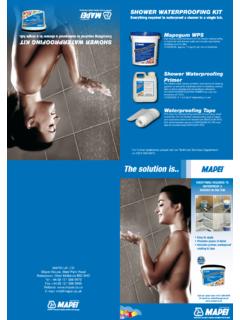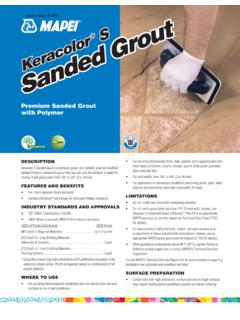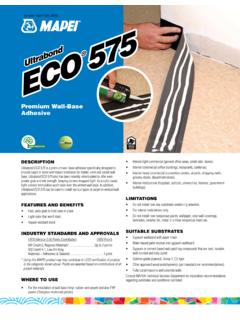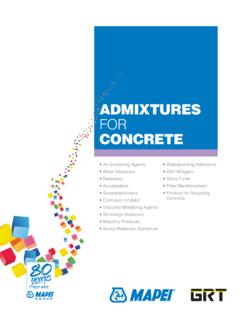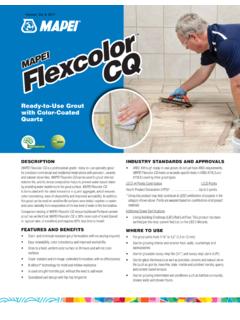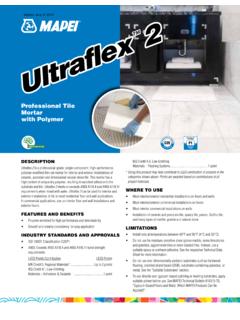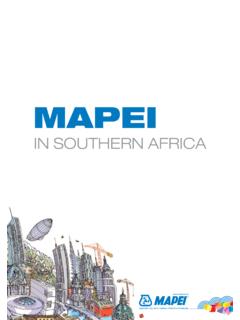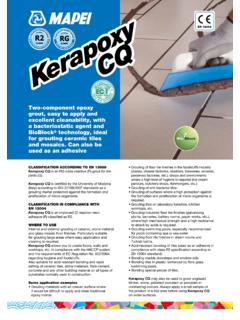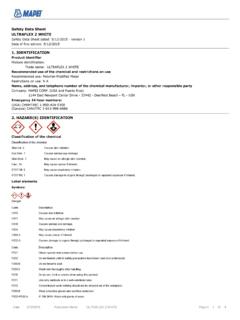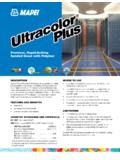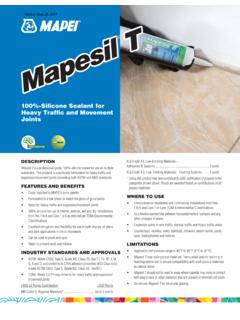Transcription of flexible Waterproofing and crack-isolation membrane - Mapei
1 DeScRiptionMapelastic HPG is a ready-to-use, highly flexible , liquid acrylic Waterproofing membrane for installation under ceramic tile or stone on residential and light commercial interior floors and walls. Applied with a roller, trowel or brush, Mapelastic HPG has excellent compatibility with cement-based mortars. When installed with Mapei s Fiberglass Mesh, Mapelastic HPG can also be used as a crack - isolation membrane and meets ANSI standards for Waterproofing . In addition, Mapelastic HPG is IAPMO-listed for use as a shower-pan anD benefitS Dual protection: Provides Waterproofing and crack isolation Prevents in-plane floor cracks from transmitting through tile or stone Compatible with Mapei s Fiberglass Mesh and Mapeband accessories Compatible with Mapei mortars and grouts for complete system protection Durable and flexible ; bonds to a wide range of surfaces Ready to use; easy to apply with roller, trowel or brush Install tile or stone after curing for 16 to 24 hours.
2 Flood-test after 72-hour cure. inDUStRy StanDaRDS anD appRoValSANSI : Exceeds ASTM C627 (Robinson): Extra heavy service rating LEED (Version ) Points Contribution LEED PointsMR Credit 5, Regional Materials*..Up to 2 points IEQ Credit , Low-Emitting Materials Paints & Coatings ..1 point* Using this Mapei product may help contribute to LEED certification of projects in the categories shown above. Points are awarded based on contributions of all project to USe For interior Waterproofing vertically and horizontally behind tile and stone installations in residential to light commercial bathrooms, restrooms, kitchens and laundry rooms As a crack - isolation membrane over existing in-plane cracks up to 1/8" (3 mm) (see One-Coat System instructions) and for handling up to an additional 1/8" (3 mm) in-plane movement (see Two-Coat System instructions) when applied at the appropriate application thickness and system (see section Pre-treat existing in-plane cracks below) limitationS Do not use over any substrates containing asbestos.
3 Do not apply directly over gypsum-based patching or leveling compounds (see Suitable Substrates section below), sheet vinyl, vinyl composition tile (VCT), self-stick tile, laminate surfaces, metal or fiberglass surfaces, or poured epoxy floors. Do not apply directly over substrates consisting of plank wood flooring, presswood, particleboard, chipboard, oriented strand board (OSB), pressure-treated plywood, oil-treated plywood, Luaun plywood, Masonite flexible Waterproofing and crack - isolation membrane Mapelastic HPG Mapelastic HPG or other dimensionally unstable materials. Do not use over cracks or control joints subject to out-of-plane movement, or in-plane movement greater than 1/8" (3 mm).
4 Do not use where excessive substrate moisture and/or where negative hydrostatic pressure exists. The maximum amount of acceptable moisture in a concrete substrate for Mapelastic HPG is 3 lbs. per 1,000 sq. ft. (1,36 kg per 92,9 m2) per 24 hours as determined by a calcium chloride test kit. When the moisture vapor emission rate (MVER) is in excess of 3 lbs. per 1,000 sq. ft. (1,36 kg per 92,9 m2) per 24 hours, contact Mapei s Technical Services for recommendations. Do not use for constant immersion, on plywood in exterior applications, as a roof deck membrane , or as a wear surface. Do not use with solvent-based materials. Do not use premixed mastics to set tile over Mapelastic HPG.
5 Use only a Mapei epoxy or urethane setting material when installing moisture-sensitive natural stone or manmade tiles, such as agglomerates, over Mapelastic HPG. Note: On occasion, dimensionally weak natural stone tile that normally would not be categorized as moisture-sensitive (such as travertine, limestone, marble and agglomerates) can exhibit doming, cupping or curling when using wet-set or medium-bed mortar methods of installation over impervious sheet membranes such as Mapelastic HPG. For this reason, areas requiring more than 3/8" (10 mm) buildup require the use of a self-leveling underlayment or cured mud-bed application before installation of Mapelastic HPG. When installing natural stone, always do a mockup area of the proposed installation and allow materials to reach full cure to ensure achieving the desired effect.
6 For more information regarding these methods or materials, contact Mapei s Technical Services before installation or SUbStRateS (interior only; properly prepared) Fully cured concrete at least 28 days old (see Limitations ) Masonry walls of cement block or brick Cured cement mortar beds and leveling coats Cement backer units (CBUs) Well-bonded, unglazed ceramic and porcelain tile, quarry tile and cement terrazzo floors. Note: Existing unglazed ceramic tile must be abraded, and existing cement terrazzo must be mechanically profiled. Both must be skimcoated with an appropriate Mapei latex or polymer-modified mortar. Well-bonded, unglazed ceramic, porcelain and quarry tile Gypsum wallboard (walls only, primed, in approved application areas only) Properly prepared radiant-heated, cement-based substrates Exterior-grade plywood for interior residential floors and countertops in dry areas only.
7 Plywood must be Group 1, CC-type, conforming to APA classification and Product Standard PS 1-95 or COFI exterior plywood Select or Select Tight Face conforming to CSA-0121 standard for Douglas fir. (See TCA Handbook for additional information and following statement regarding deflection.) PVC, copper, brass, stainless steel penetrations (abraded)Consult Mapei s Technical Services Department for installation recommendations regarding substrates and conditions not listed. Tile Council of North America (TCNA) Statement on deflection Criteria Floor systems, including the framing system and subfloor panels, over which tile will be installed should be in conformance with the IRC [International Residential Code] for residential applications, the IBC [International Building Code] for commercial applications, or applicable building codes.
8 Note: The owner should communicate in writing to the project design professional and general contractor the intended use of the tile installation, in order to enable the project design professional and general contractor to make necessary allowances for the expected live load, concentrated loads, impact loads, and dead loads including the weight of the tile and setting bed. The tile installer shall not be responsible for any floor framing or subfloor installation not compliant with applicable building codes, unless the tile installer or tile contractor designs and installs the floor framing or pRepaRation Apply when substrate and ambient temperatures are between 50 F and 95 F (10 C and 35 C).
9 All suitable substrates must be smooth, structurally sound and free of any substance that could prevent adhesion. Do not use chemical means (acid etching or stripping) to prepare approved substrates. Use mechanical methods only. To remove any bond-inhibiting materials, concrete substrates should be mechanically cleaned and prepared by diamond-cup grinding or other engineer-approved Mapelastic HPG Mapelastic HPG methods to obtain the International Concrete Repair Institute (ICRI) concrete surface profile #2. When concrete requires more mechanical preparation, the profile will typically increase. In such cases, the surface can be made smooth by applying coats of Mapei s Planipatch.
10 For details, see Mapei s Surface Preparation Requirements document for tile and stone installations at , or contact Mapei s Technical Services HPG is ready to use. No additional mixing is application A. one-Coat System For general Waterproofing and 1/8" (3 mm) In-Plane crack IsolationPre-treat existing in-plane cracks, up to 1/8" (3 mm) wide1. For expansion and control joints, see Expansion and Control Joints section. 2. Use a 1/8" (3 mm) V-notched trowel, short-nap (3/8" [10 mm]) roller or paintbrush to apply Mapelastic HPG at 40 mils (1 mm) in thickness and about 13" (33 cm) in width, centered over the cracks. 3. Embed a 12" (30 cm) wide piece of Mapei s Fiberglass Mesh, with a roller or the trowel s flat side, into the fresh Mapelastic HPG.
